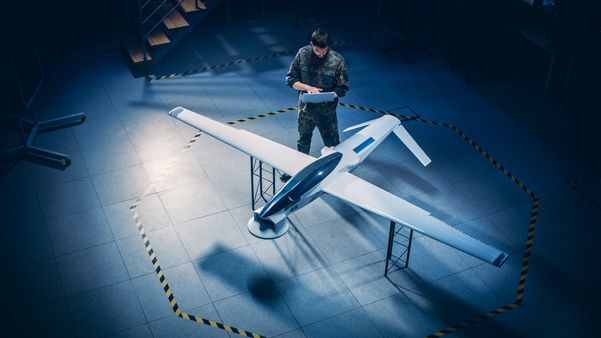From the earliest days of the War on Terror, the U.S. has had one weapon that none of its enemies -- and few of its allies -- possessed: drones. Specifically, MQ-1 Predator drones built by privately held defense contractor General Atomics.
MQ-1 Predator. Image source: U.S. Air Force.
Twenty-seven feet long and sporting a 55-foot wingspan, the Predator is nearly as big as an F-16 fighter jet, but weighs just one-sixteenth as much. With its tiny 115-horsepower engine, the Predator buzzes through the air at just 84 miles per hour.
It can only fly about 770 miles -- less than half the range of an F-16. But that's far enough to make the drone a valuable surveillance asset -- and armed with two laser-guided AGM-114 Hellfire missiles, the Predator can shoot, as well as search. But now, it's the Predator itself that's in the crosshairs -- of the U.S. Air Force.
Requiem for a Predator
As reported last week on Flightglobal.com, the U.S. Air Force "is currently on track to retire all [145 of its] MQ-1 Predators and move to an all-MQ-9 fleet with an estimated completion in 2018." News mil-tech website FoxtrotAlpha lamented that "throngs of perfectly flyable MQ-1s" will "be sent to the boneyard."
Apparently, the plan is not just to mothball these Predators for use at a later date. Rather, the drones will be placed in "non-recoverable storage" -- left to rot in the Arizona desert. Henceforth, their duties will be taken over by General Atomics' successor aircraft, the much larger MQ-9 Reaper.
MQ-9 Reaper. Image source: U.S. Air Force.
MQ-9: Not nine times better than MQ-1 -- but close
Why retire the Predator in favor of the Reaper? According to the Air Force's specifications, the MQ-9 Reaper offers a much more robust platform than the MQ-1 Predator -- for surveillance, and for attack, as well.
Reaper measures 66 feet across the wings, and is 36 feet long. Its 4,900-pound curb weight is more than four times as massive as the Predator, and Reaper can carry twice as many Hellfire missiles as Predator can -- and lug along two 500-pound smart bombs for the ride.
Most crucially, Reaper's 900-horsepower engine can carry the Reaper 50% farther (a 1,150 mile-range). At a cruising speed of 230 mph, Reaper can get on-station nearly three times as fast as a Predator can.
What it means to investors
That last factor -- Reaper's superiority to Predator for long-range missions -- appears to have been key to the Air Force's decision to retire the one drone and switch to the other. But just as important in a constrained spending environment is the fact that, while a Reaper costs about three times as much as a Predator to buy, it costs only about 29% more to fly.
A 2013 report from the U.S. Air Force comptroller's office confirms that the Reaper's cost per flight hour is only $4,762 versus $3,679 for the Predator. Given that a Reaper gives the Air Force 50% more range, and more than twice the payload of a Predator, switching to an all-Reaper drone force makes sense.
It does, however, risk opening up a hole in the Air Force's capabilities: namely, its ability to fly shorter-range reconnaissance missions economically. Even at just $4,762 an hour, you don't necessarily want to spin up the propellers on a Reaper for a local surveillance flight if a cheaper option is available. With the Predators going away, there may be an opportunity opening up for makers of shorter-range surveillance drones to poach some business from General A.
Who are these drone makers? Well, you can buy a brand-new RQ-11 Raven unmanned aerial vehicle from AeroVironment (AVAV 2.07%) for just $34,000 -- the cost of just seven hours' flying time in a Reaper. For that matter, a Textron (TXT 0.69%) RQ-7 Shadow boasts ranges and speeds similar to the soon-to-be-retired Predator, and for a cost of 25% less.
Now, both Aerovronment's and Textron's drone systems are currently favored by the U.S. Army rather than the Air Force. But think about the U.S. military as a mission, rather than a handful of isolated services performing independent missions. Once the Predator goes away, it's possible that shorter-range surveillance operations will shift more toward the Army, and away from the Air Force in the future. Logically, this would create more need for Ravens and Shadow drones to accomplish these missions.
Nostalgia aside, the retirement of the Predator fleet just might be good news for investors in Aerovironment and Textron.
AeroVironment's Raven -- not as scary-looking as a Predator, but not as expensive as a Predator, either. Image source: AeroVironment.










